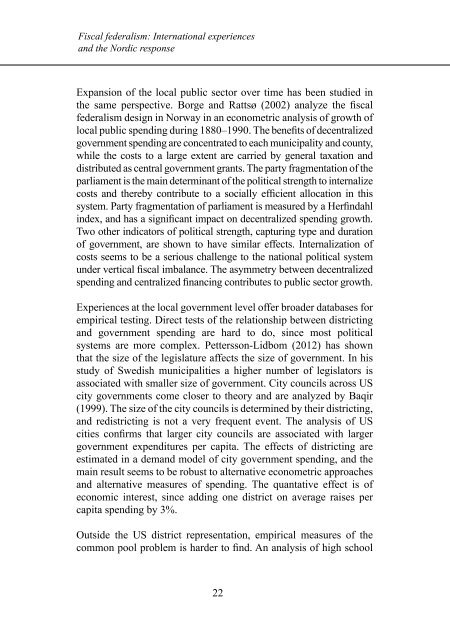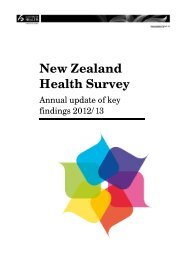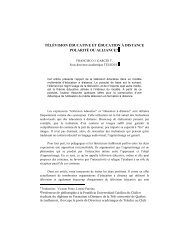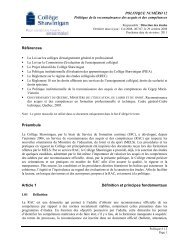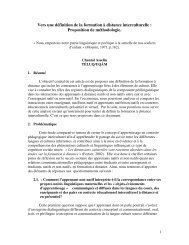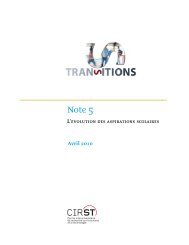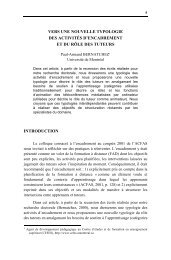61 Rethinking local government: Essays on municipal reform - VATT
61 Rethinking local government: Essays on municipal reform - VATT
61 Rethinking local government: Essays on municipal reform - VATT
You also want an ePaper? Increase the reach of your titles
YUMPU automatically turns print PDFs into web optimized ePapers that Google loves.
Fiscal federalism: Internati<strong>on</strong>al experiencesand the Nordic resp<strong>on</strong>seExpansi<strong>on</strong> of the <str<strong>on</strong>g>local</str<strong>on</strong>g> public sector over time has been studied inthe same perspective. Borge and Rattsø (2002) analyze the fiscalfederalism design in Norway in an ec<strong>on</strong>ometric analysis of growth of<str<strong>on</strong>g>local</str<strong>on</strong>g> public spending during 1880–1990. The benefits of decentralized<str<strong>on</strong>g>government</str<strong>on</strong>g> spending are c<strong>on</strong>centrated to each <strong>municipal</strong>ity and county,while the costs to a large extent are carried by general taxati<strong>on</strong> anddistributed as central <str<strong>on</strong>g>government</str<strong>on</strong>g> grants. The party fragmentati<strong>on</strong> of theparliament is the main determinant of the political strength to internalizecosts and thereby c<strong>on</strong>tribute to a socially efficient allocati<strong>on</strong> in thissystem. Party fragmentati<strong>on</strong> of parliament is measured by a Herfindahlindex, and has a significant impact <strong>on</strong> decentralized spending growth.Two other indicators of political strength, capturing type and durati<strong>on</strong>of <str<strong>on</strong>g>government</str<strong>on</strong>g>, are shown to have similar effects. Internalizati<strong>on</strong> ofcosts seems to be a serious challenge to the nati<strong>on</strong>al political systemunder vertical fiscal imbalance. The asymmetry between decentralizedspending and centralized financing c<strong>on</strong>tributes to public sector growth.Experiences at the <str<strong>on</strong>g>local</str<strong>on</strong>g> <str<strong>on</strong>g>government</str<strong>on</strong>g> level offer broader databases forempirical testing. Direct tests of the relati<strong>on</strong>ship between districtingand <str<strong>on</strong>g>government</str<strong>on</strong>g> spending are hard to do, since most politicalsystems are more complex. Petterss<strong>on</strong>-Lidbom (2012) has shownthat the size of the legislature affects the size of <str<strong>on</strong>g>government</str<strong>on</strong>g>. In hisstudy of Swedish <strong>municipal</strong>ities a higher number of legislators isassociated with smaller size of <str<strong>on</strong>g>government</str<strong>on</strong>g>. City councils across UScity <str<strong>on</strong>g>government</str<strong>on</strong>g>s come closer to theory and are analyzed by Baqir(1999). The size of the city councils is determined by their districting,and redistricting is not a very frequent event. The analysis of UScities c<strong>on</strong>firms that larger city councils are associated with larger<str<strong>on</strong>g>government</str<strong>on</strong>g> expenditures per capita. The effects of districting areestimated in a demand model of city <str<strong>on</strong>g>government</str<strong>on</strong>g> spending, and themain result seems to be robust to alternative ec<strong>on</strong>ometric approachesand alternative measures of spending. The quantative effect is ofec<strong>on</strong>omic interest, since adding <strong>on</strong>e district <strong>on</strong> average raises percapita spending by 3%.Outside the US district representati<strong>on</strong>, empirical measures of thecomm<strong>on</strong> pool problem is harder to find. An analysis of high school22


